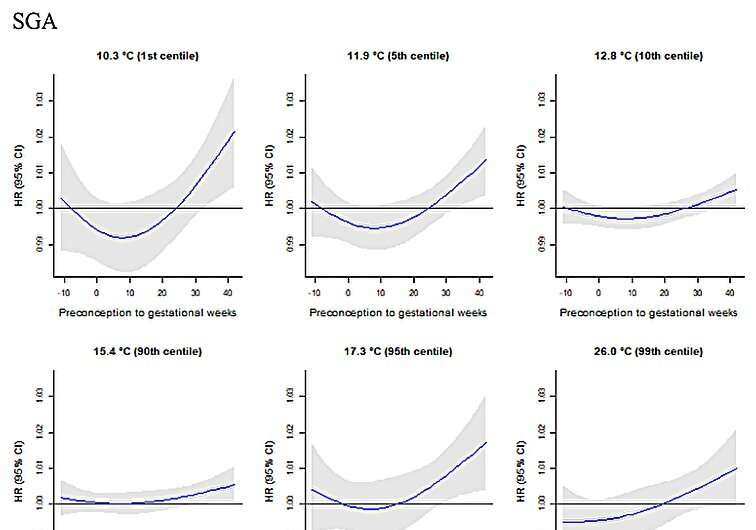This article has been reviewed according to Science X's editorial process and policies. Editors have highlighted the following attributes while ensuring the content's credibility:
fact-checked
peer-reviewed publication
trusted source
proofread
Climate change could be impacting Australian babies' birthweight for gestational age

Climate change could pose a big risk to Australians' reproductive health, claims a new, large-scale Curtin University study revealing a possible link between extreme bioclimatic exposure during pregnancy and babies' birthweights for gestational age.
Researchers from the Curtin School of Population Health examined more than 385,000 pregnancies in Western Australia between 2000 and 2015, from 12 weeks prior to conception until birth.
These pregnancies included 9.8% and 9.9% of children born too small and large for gestational age, respectively.
The study, titled "Critical windows of maternal exposure to biothermal stress and birth weight for gestational age in Western Australia" was published in Environmental Health Perspectives.
The team focused on the relationship between low and high birthweights for gestational age and a person's outdoor heat or cold (biothermal) stress exposures during pregnancy.
To do this, the researchers used the Universal Thermal Climate Index (UTCI), a modern composite biothermal tool that describes a person's physiological response to the thermal environment.
It's the first study to use the UTCI to measure bioclimatic exposure before and during pregnancy and the risks of being born too small or large for gestational age.
It found exposure to low and high biothermal stress during specific times in pregnancy appeared to be linked to a higher risk of babies being smaller or larger for their gestational ages at birth.
The average biothermal exposure was between 8.1°C and 30.0°C, a range that indicated slight cold stress and moderate heat stress on the UTCI scale.
The study revealed extreme biothermal exposures—1st percentile (cold stress) and 99th percentile (heat stress), as compared to the median (no thermal stress), seemed to be most associated with changes in birthweight for gestational age.
Study lead Dr. Sylvester Dodzi Nyadanu said this was especially true during particular stages of pregnancy.
"A baby's size at birth is strongly associated with mortality risk during the first year, with developmental problems in childhood and the risk of various diseases in adulthood," Dr. Nyadanu said.
"These findings support our concerns that the risk of having a baby too small or large for its gestational age appears to increase with exposure to environmental conditions that cause biothermal stress in the latter stages of pregnancy.
"We also found other subpopulations were at higher risk of abnormal fetal growth due to exposure to biothermal stress, including non-Caucasian people, male births, pregnancies in those aged 35 and above, those in rural areas, and those who smoked during pregnancy."
Dr. Nyadanu said the study was part of growing evidence of climate change's threat to reproductive health by exacerbating heat or cold waves, vector-borne diseases, natural disasters such as cyclones, floods, droughts and wildfires, food and water insecurity and altering many natural and social environments which are worsening existing health challenges.
"Thermal stress exposures increase dehydration and induce oxidative stress and systemic inflammatory responses, leading to adverse reproductive and fetal health outcomes," he said.
"Our research adds to the growing collection of observational studies reporting on maternal exposure to ambient temperature and pregnancy outcomes such as pregnancy complications, preterm birth, stillbirth, and low birth weight.
"There needs to be further studies into what interventions will achieve better results for parents and babies—especially in the specific vulnerable subpopulations identified in our study.
"Pregnancy is a vulnerable period for climate change and so any climate care intervention is reproductive health care."
More information: Sylvester Dodzi Nyadanu et al, Critical Windows of Maternal Exposure to Biothermal Stress and Birth Weight for Gestational Age in Western Australia, Environmental Health Perspectives (2023). DOI: 10.1289/EHP12660



















